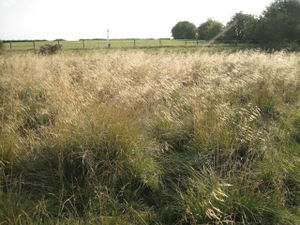Difference between revisions of "Deschampsia cespitosa"
| Line 1: | Line 1: | ||
| − | + | {{Taxobox | |
| − | + | | name = Deschampsia cespitosa| image = 2586885 b96ce141.jpg | |
| − | ''' | + | | image_alt = Deschampsia cespitosa |
| − | + | | image_caption = Deschampsia cespitosa | |
| − | '' | + | | regnum = [[Plant]]ae |
| + | | subregnum = Tracheobionta | ||
| + | | phylum = Spermatophyta | ||
| + | | subphylum= Magnoliophyta | ||
| + | | classis = Magnoliopsida | ||
| + | | subclassis = Lilianae | ||
| + | | ordo = Poales | ||
| + | | familia = Poaceae | ||
| + | | genus = ''Deschampsia'' | ||
| + | | species = ''Deschampsia cespitosa'' | ||
| + | | binomial = | ||
| + | | binomial_authority = | ||
| + | | synonyms = | ||
*''Agrostis caespitosa'' (L.) Salisb. | *''Agrostis caespitosa'' (L.) Salisb. | ||
*''Aira alpicola (Rydb.)'' Rydb. | *''Aira alpicola (Rydb.)'' Rydb. | ||
| Line 24: | Line 36: | ||
*''Deschampsia pungens'' Rydb. | *''Deschampsia pungens'' Rydb. | ||
*''Podionapus caespitosus'' (L.) Dulac | *''Podionapus caespitosus'' (L.) Dulac | ||
| + | }} | ||
| + | |||
| + | |||
| + | '''Common name:''' tufted hairgrass, Beringian grass. | ||
| + | |||
| + | '''Abbreviation code (Codon):''' DECE | ||
| + | |||
| − | |||
| − | |||
| − | |||
| − | |||
| − | |||
| − | |||
| − | |||
| − | |||
| − | |||
| − | |||
| − | |||
| − | |||
==Description== | ==Description== | ||
Revision as of 12:07, 4 June 2012
| Deschampsia cespitosa | |
|---|---|

| |
| Deschampsia cespitosa | |
| Scientific classification | |
| Kingdom: | Plantae |
| Subkingdom: | Tracheobionta |
| Phylum: | Spermatophyta |
| Subphylum: | Magnoliophyta |
| Class: | Magnoliopsida |
| Subclass: | Lilianae |
| Order: | Poales |
| Family: | Poaceae |
| Genus: | Deschampsia |
| Species: | Deschampsia cespitosa |
| Synonyms | |
| |
Common name: tufted hairgrass, Beringian grass.
Abbreviation code (Codon): DECE
Contents
Description
Tufted hairgrass is a densely cespitose cool-season native perennial bunchgrass. Culms are hollow, slender, erect, and 8 to 48 inches (20-120 cm) in height.
Abundant leaves form basal tufts; blades are 0.8 to 13 inches (2-33 cm) long and 0.04 to 0.16 inch (1-4 mm) wide.
The inflorescence is generally a loose, open panicle, though occasionally narrow and contracted; it is 4 to 12 inches (10-30 cm) long.
Branches are whorled, hairlike, and spikelet-bearing near their tips. Spikelets are two- to occasionally three-flowered. Lemmas are awned toward the base. The fruit is a caryopsis.
Bloom Period
Blooms in June, fruit ripens through summer and fall.
Distribution
Transcontinental Canada, s. to NC, WV, Great Lakes, ND, mts. of NM, AZ & CA
Habitat
Deschampsia cepitosa occurrence is circumglobal, extending throughout cooler regions of the northern Hemisphere. In Oregon and Washington, sites with tufted hairgrass include seasonally wet soils in low lying areas of the western interior valleys, tidal mudflats and estuarine plant communities near the coast, poorly drained fields, and moist mountain meadows. It can form nearly pure stands in wet or intermittently flooded areas. The species is highly variable.
Occurs in fine, medium and coarse soils – sandy loam, sandy clayey loam, silty loam, loam, loamy clay, and clay. Tufted hairgrass growth is rated fair on sandy loam and good on loam and clayey loam.
Uses
Tufted hairgrass is frequently grazed by bears. Sitka black-tailed deer and feral horses consume tufted hairgrass. Larval host and/or nectar source for Umber Skipper. Attracts birds.
First Nations people report that seeds of Deschampsia species were eaten by indigenous Californians.
Propagation
Tufted hairgrass can be grown for seed on well drained medium to fine textured soils on uplands as well as on poorly-drained silts and clays in low lying areas. If seasonally flooded areas are to be used for seed production, fields must be firm enough to perform weed control measures and dry enough to windrow and harvest by as early as mid-June (western Oregon). This species is broadly adapted to soils that are acid to neutral (pH 4.5-7.0).
Good results from fall sowing. In a nursery, sow in containers in April on heat (night -15º C, days 20-24º C), germination in 30 days. Cover lightly with soil and screen until germination occurs. Plugs form slowly in about 60 days if kept continually moist and at a constant temperature (S. Bastin, pers. comm.).
Can be very aggressive. Leave room to spread or control in place. Doesn't tolerate transplanting unless well-rooted (S. Bastin, pers. comm.).
Photo Gallery
Seed
Average Measurement with husk/awn: 3.4 x 0.8 x 0.8
Average Measurement without husk/awn: 1.8 x 0.6 x 0.6
Measurement Range with husk/awn: L: 2.5 – 4.5, W: 0.5 – 1, D: 0.6 – 1
Measurement Range with husk/awn: L: 1.5 – 2, W: 0.5 – 0.75, D: 0.5 – 0.6
Features
Shape: Seed narrow at hilum and opposite apex, rounded in the middle.
Additional Structures: Lemma thin, and have several nerves running across them. Awn originates from the hilum and is about 1 ½ times the length of the seed body. Hilum bearded with feather like appendage. Palea also thin.
Color: Tan palea and lemma, awn slightly darker brown. Inner seed red-brown, and somewhat transparent.
Surface: Seed finely longitudinally striate and lustrous. Awn finely barbed.
Latitudinal Cross Section: elliptical 
Longitudinal Cross Section: elliptical ![]()


